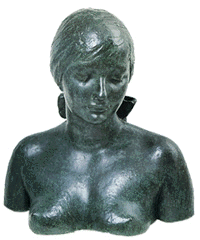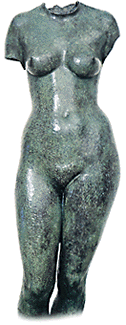...Best of Sicily
presents... Best of Sicily Magazine. ... Dedicated to Sicilian art, culture, history, people, places and all things Sicilian. |
by Antonella Gallo | ||
Magazine Best of Sicily Arts & Culture Fashion Food & Wine History & Culture About Us Travel Faqs Contact Map of Sicily |
His Fascism (he was a longtime party member) was sufficient to bring about a brief post-war suspension of his tenure as director of the Brera Academy. The artist's association with the Fascist Party may have been a simple question of opportunism, since it facilitated his receiving public appointments and public commissions. The art itself rarely bore an overtly political message, but, following the Second World War, sometimes dealt with themes like war and violence. The statement was never overbearing. He preferred bronze. Ever a realist, Messina never deviated much from
the natural form, except in slight stylizations. Punctuated by the occasional
exhibit, his professional life consisted of creating and teaching. In He did not shy away from private commissions or smaller works, and created many for his own pleasure or for eventual sale by galleries or his own workshop. Never a showman, Messina rarely sought public attention, though the media loved him. In one of his last interviews, he observed that art should not be viewed as a status symbol. He seemed to resent this trend, which he believed had become more pronounced in recent decades. Words often fall short of describing art or artists, but it's obvious that Messina was a classicist. This wasn't always "politically correct," but it was usually popular. That's not to say that interpretation was never present in his work. Indeed, it is especially demanding to work within realism's rigid parameters, much moreso to actually evolve within them, as Messina did. His was art without apologies. Francesco Messina visited Sicily over the years, but resided in Milan even in his nineties. He died there in 1995. His work is being shown in a retrospective exhibit at the La Murzia Gallery in Palermo through June 17th. About the Author: Artist Antonella Gallo teaches art in Rome. | |
Top of Page |
 He spent most of his life outside his native Sicily, as an "expatriate" in the
Italian North. But Francesco Messina was identified, for most of his long
professional career, as a Sicilian realist sculptor. It was not always a
fashionable label, but it was what defined the talent and the man. Truth
be told, he was little known outside Italy, though his commissioned works
can be seen in a number of countries, and he sometimes exhibited internationally.
Francesco Messina was born in Linguaglossa, in the province of Catania,
in 1900. He spent most of his youth in Genoa. As a young artist, he was
an excellent draftsman, and found an early affinity for the human form.
He soon began to sculpt in clay (terra cotta) and other media. In the 1930s,
his sculpture was exhibited throughout Europe in group shows of Italian
artists. In 1932, he moved to Milan, and was soon appointed a tenured professor
at that city's Brera Art Academy. In 1935, he completed the Christopher
Columbus Monument for the city of Chiavari.
He spent most of his life outside his native Sicily, as an "expatriate" in the
Italian North. But Francesco Messina was identified, for most of his long
professional career, as a Sicilian realist sculptor. It was not always a
fashionable label, but it was what defined the talent and the man. Truth
be told, he was little known outside Italy, though his commissioned works
can be seen in a number of countries, and he sometimes exhibited internationally.
Francesco Messina was born in Linguaglossa, in the province of Catania,
in 1900. He spent most of his youth in Genoa. As a young artist, he was
an excellent draftsman, and found an early affinity for the human form.
He soon began to sculpt in clay (terra cotta) and other media. In the 1930s,
his sculpture was exhibited throughout Europe in group shows of Italian
artists. In 1932, he moved to Milan, and was soon appointed a tenured professor
at that city's Brera Art Academy. In 1935, he completed the Christopher
Columbus Monument for the city of Chiavari. 1958, he executed the bust of Giacomo Puccini for La Scala and, in 1963, the statue of Pius XII in Saint Peter's Basilica. Among his admirers were Jean
Cocteau and Salvatore Quasimodo, but in an age of abstract movements Messina's
works found favor among many who felt alienated by the new wave of expressionist
sculpture. His own expression was often subtle. Only up close does one realize
that Paola (1967), shown here, is shedding a tear.
1958, he executed the bust of Giacomo Puccini for La Scala and, in 1963, the statue of Pius XII in Saint Peter's Basilica. Among his admirers were Jean
Cocteau and Salvatore Quasimodo, but in an age of abstract movements Messina's
works found favor among many who felt alienated by the new wave of expressionist
sculpture. His own expression was often subtle. Only up close does one realize
that Paola (1967), shown here, is shedding a tear.